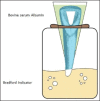Coronal microleakage of three different dental biomaterials as intra-orifice barrier during nonvital bleaching
- PMID: 26759596
- PMCID: PMC4696362
- DOI: 10.4103/1735-3327.170582
Coronal microleakage of three different dental biomaterials as intra-orifice barrier during nonvital bleaching
Abstract
Background: This study was designed to assess the microleakage of glass-ionomer (GI), mineral trioxide aggregate (MTA), and calcium-enriched mixture (CEM) cement as coronal orifice barrier during walking bleaching.
Materials and methods: In this experimental study, endodontic treatment was done for 70 extracted human incisors without canal calcification, caries, restoration, resorption, or cracks. The teeth were then divided into three experimental using "Simple randomization allocation" (n = 20) and two control groups (n = 5). The three cements were applied as 3-mm intra-orifice barrier in test groups, and bleaching process was then conducted using a mixture of sodium perborate powder and distilled water, for 9 days. For leakage evaluation, bovine serum albumin marker was traced in a dual-chamber technique with Bradford indicator. The Kruskal-Wallis and Mann-Whitney tests were used for statistical analysis.
Results: The mean ± standard deviation leakage of samples from negative control, positive control, GI, MTA, and CEM cement groups were 0.0, 8.9 ± 0.03, 0.47 ± 0.02, 0.48 ± 0.02, and 0.49 ± 0.02 mg/mL, respectively. Statistical analysis showed no significant difference between three experimental groups (P > 0.05).
Conclusion: It is concluded that GI, MTA, and CEM cements are considered as suitable intra-orifice barrier to provide coronal seal during walking bleaching.
Keywords: Calcium enriched mixture cement; RMGIC; WMTA; coronal barrier; nonvital bleaching.
Figures
Similar articles
-
In Vitro Microleakage of Mineral Trioxide Aggregate, Calcium-Enriched Mixture Cement and Biodentine Intra-Orifice Barriers.Iran Endod J. 2017 Spring;12(2):211-215. doi: 10.22037/iej.2017.41. Iran Endod J. 2017. PMID: 28512488 Free PMC article.
-
In Vitro Sealing Properties of Calcium-Enriched Mixture and Mineral Trioxide Aggregate Orifice Barriers during Intra-Coronal Bleaching.Iran Endod J. 2017 Spring;12(2):231-235. doi: 10.22037/iej.2017.45. Iran Endod J. 2017. PMID: 28512492 Free PMC article.
-
The sealing ability of different endodontic biomaterials as an intra-orifice barrier: evaluation with high-performance liquid chromatography.Biomater Investig Dent. 2024 Jul 24;11:41069. doi: 10.2340/biid.v11.41069. eCollection 2024. Biomater Investig Dent. 2024. PMID: 39070047 Free PMC article.
-
Microleakage comparison of glass-ionomer and white mineral trioxide aggregate used as a coronal barrier in nonvital bleaching.Med Oral Patol Oral Cir Bucal. 2011 Nov 1;16(7):e1017-21. doi: 10.4317/medoral.17306. Med Oral Patol Oral Cir Bucal. 2011. PMID: 21743399
-
Evaluation of coronal microleakage of intra-orifice barrier materials in endodontically treated teeth: A systematic review.J Conserv Dent. 2022 Nov-Dec;25(6):588-595. doi: 10.4103/jcd.jcd_377_22. Epub 2022 Oct 13. J Conserv Dent. 2022. PMID: 36591578 Free PMC article. Review.
Cited by
-
In Vitro Microleakage of Mineral Trioxide Aggregate, Calcium-Enriched Mixture Cement and Biodentine Intra-Orifice Barriers.Iran Endod J. 2017 Spring;12(2):211-215. doi: 10.22037/iej.2017.41. Iran Endod J. 2017. PMID: 28512488 Free PMC article.
-
In Vitro Sealing Properties of Calcium-Enriched Mixture and Mineral Trioxide Aggregate Orifice Barriers during Intra-Coronal Bleaching.Iran Endod J. 2017 Spring;12(2):231-235. doi: 10.22037/iej.2017.45. Iran Endod J. 2017. PMID: 28512492 Free PMC article.
-
Importance and methodologies of endodontic microleakage studies: A systematic review.J Clin Exp Dent. 2017 Jun 1;9(6):e812-e819. doi: 10.4317/jced.53604. eCollection 2017 Jun. J Clin Exp Dent. 2017. PMID: 28638561 Free PMC article. Review.
-
Comprehensive review of composition, properties, clinical applications, and future perspectives of calcium-enriched mixture (CEM) cement: a systematic analysis.Biomed Eng Online. 2024 Sep 18;23(1):96. doi: 10.1186/s12938-024-01290-4. Biomed Eng Online. 2024. PMID: 39294680 Free PMC article.
-
The sealing ability of different endodontic biomaterials as an intra-orifice barrier: evaluation with high-performance liquid chromatography.Biomater Investig Dent. 2024 Jul 24;11:41069. doi: 10.2340/biid.v11.41069. eCollection 2024. Biomater Investig Dent. 2024. PMID: 39070047 Free PMC article.
References
-
- Zimmerli B, Jeger F, Lussi A. Bleaching of nonvital teeth. A clinically relevant literature review. Schweiz Monatsschr Zahnmed. 2010;120:306–20. - PubMed
-
- Elfallah HM, Swain MV. A review of the effect of vital teeth bleaching on the mechanical properties of tooth enamel. N Z Dent J. 2013;109:87–96. - PubMed
-
- Abbott P, Heah SY. Internal bleaching of teeth: An analysis of 255 teeth. Aust Dent J. 2009;54:326–33. - PubMed
-
- Hachmeister DR, Schindler WG, Walker WA, 3rd, Thomas DD. The sealing ability and retention characteristics of mineral trioxide aggregate in a model of apexification. J Endod. 2002;28:386–90. - PubMed
-
- Heithersay GS. Invasive cervical resorption: An analysis of potential predisposing factors. Quintessence Int. 1999;30:83–95. - PubMed



